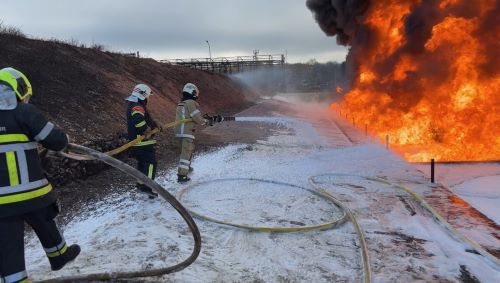
Developing a PFAS Worker Protection Program
November 29, 2023
By: Tiffany Kornberg, PhD and Angie Perez, PhD, CIH
Introduction
Protecting employees is of the utmost importance for any business. This is certainly true in the case of workers who use Aqueous Film Forming Foams (AFFFs) that potentially contain per- and polyfluoroalkyl substances (PFAS). AFFFs are chemical agents specifically designed to suppress and extinguish fires and vapors involving flammable liquids, such as oil, gasoline, jet fuel, and other hydrocarbons. AFFFs are composed of complex mixtures of approximately 15 to 18 percent fluorinated and nonfluorinated surfactants; exact formulations vary over time, even between formulations produced by the same manufacturer [1–4]. In this third part of our blog series, we will discuss occupational safety and industrial requirements related to the use of AFFFs as well as the strategies for developing a worker protection program. To learn more about SFFFs, read our first and second blogs in the AFFF series.
Some AFFF formulations have been found to contain perfluorooctanesulfonate (PFOS) and perfluorohexanesulfonate (PFHxS), as well as small amounts of other PFAS including, perfluorobutanesulfonate (PFBS), perfluoropentanesulfonate (PFPeS), perfluoroheptanesulfonate (PFHpS), perfluoropentanoic acid (PFPeA), perfluorohexanoic acid (PFHxA), and perfluoroheptanoic acid (PFHpA) [5–7]. Minimizing any unnecessary chemical exposure in the workplace and having a written plan outlining the steps for compliance is prudent. The ever-changing landscape of PFAS regulations, including recently proposed drinking water standards, release reporting requirements, and the designation status of PFAS as CERCLA hazardous substances highlights the importance of developing a PFAS worker protection program to reduce potential work-related exposures to PFAS via contact with AFFF and to minimize potential downstream liabilities.
History of AFFF and its potential for occupational exposure
Serving both emergency response and training objectives, AFFFs have been used extensively at airports, oil refineries, chemical manufacturers, military bases, train yards, ships, and other locations for their fire and vapor suppression properties [5,8,9]. As a result of their widespread use, there is potential for workers to be exposed to AFFF during active fire suppression activities and relevant training exercises [10] Multiple studies have shown elevated concentrations of PFAS in the blood or urine of firefighters following active firefighting operations in the United States and Europe [11–14]. In cases involving firefighters, exposure likely occurs via inhalation or oral intake of AFFF during occupational tasks, as dermal uptake of PFAS is considered a tertiary route of exposure behind oral intake and inhalation [10,15] Additionally, contaminated personal protective equipment (PPE) may increase the risk of hand-to-mouth transfer of these compounds, particularly if firefighting turnout gear and other pieces of equipment are not appropriately cleaned between operations [10].
Health risks associated with occupational exposure
PFAS compounds, such as PFOS or PFHxS, can take years to break down and be excreted by the human body following exposure [16]. Thus, bioaccumulation of PFAS is a concern, particularly for those who may have occupational exposures in addition to exposures that occur from products used in everyday life. Additionally, the clinical relevance of PFAS bioaccumulation is unclear with regard to human health effects [17].
Data about the health effects resulting from PFAS exposure are overall inconclusive based on a growing body of peer-reviewed literature. Some epidemiological studies link PFOS or PFOA exposure to altered immune response, lipid dysregulation, and kidney or testicular cancer [18]. However, the studies that provide such evidence of these effects have critical limitations that prevent clear conclusions from being drawn, including a lack of data on the underlying mechanism of action or a reliance exclusively on studies focused on animals that have physiological structures or responses that differ from those of humans [18]. Regardless, concern for potential health effects associated with PFAS has led to an increasing number of regulations related to human exposure [19–22]. These proposed regulations primarily target drinking water contamination and exposure for the general population, rather than occupational exposures.
The use of AFFF and its direct link to elevated PFAS concentrations in the human body, as well as the subsequent potential health outcomes, is woefully understudied. Additionally, an individual involved in firefighting activities may experience multiple co-exposures, including particulate matter, volatile organic compounds, and other combustion by-products that are associated with adverse health outcomes, such as cancer. These co-exposures further confound the investigation into AFFF-related health concerns.
PFAS Worker Protection Program
There are currently no nationally published best practices for preventing PFAS exposures in the workplace, primarily because federal agencies and sometimes even companies do not understand what chemicals or products in their supply chain contain PFAS. The U.S. Environmental Protection Agency (EPA) plans to rectify this through their finalized PFAS reporting rule which requires companies to report under TSCA, where applicable, information related to chemical identity, uses, volumes produced and processed, byproducts, environmental and health effects, worker exposure, and disposal.
Currently, the following PPE is recommended when AFFF is used: rubber gloves, P2 respirators, coveralls, splash-proof goggles, and closed footwear [23]. Full firefighting turnout gear is recommended for any active firefighting operations whether they involve AFFF or not. The decontamination of PPE before re-use may play a critical role in reducing potential exposure for first responders [10]. Although there is minimal guidance on specific decontamination procedures, the Interstate Technology and Regulatory Council (ITRC) recommends general PPE decontamination approaches, including the avoidance of hand-to-mouth contact during the use or cleanup of AFFF [10,23]. Laundering of all products in equipment specifically designated for decontamination is highly recommended. Additionally, the guidelines state that personal laundry machines should not be used so PFAS are not released into municipal water treatment systems. [23]

The lack of clear information regarding proper PPE and decontamination procedures for gear worn during AFFF use reveals a critical need for improved research, as well as stop-gap safety measures to protect those who may be exposed. A PFAS worker protection program is vital not only to protect the workforce from exposure and a company from liability but also to document job tasks where worker exposures might occur. For example, a typical worker protection program involves the identification of areas where exposure might occur, evaluation of current PPE and decontamination procedures, and active or passive sampling methods to quantify the amount of exposure that is likely. From those data, Toxicologists and Industrial Hygienists can develop better safety protocols, including engineering and administrative controls, to reduce overall exposure for workers.
Ready to begin your AFFF transition journey?
References:
- Ruyle BJ, Thackray CP, McCord JP, Strynar MJ, Mauge-Lewis KA, Fenton SE, et al. Reconstructing the Composition of Per- and Polyfluoroalkyl Substances in Contemporary Aqueous Film-Forming Foams. Environ. Sci. Technol. Lett. [Internet] 2021;8:59–65. Available from: https://doi.org/10.1021/acs.estlett.0c00798
- Annunziato KM, Doherty J, Lee J, Clark JM, Liang W, Clark CW, et al. Chemical Characterization of a Legacy Aqueous Film-Forming Foam Sample and Developmental Toxicity in Zebrafish (Danio rerio). Environ. Heal. Perspect. 2020;128:097006.
- Houtz EF, Higgins CP, Field JA, Sedlak DL. Persistence of Perfluoroalkyl Acid Precursors in AFFF-Impacted Groundwater and Soil. Environ. Sci. Technol. [Internet] 2013;47:8187–95. Available from: https://doi.org/10.1021/es4018877
- Backe WJ, Day TC, Field JA. Zwitterionic, Cationic, and Anionic Fluorinated Chemicals in Aqueous Film Forming Foam Formulations and Groundwater from U.S. Military Bases by Nonaqueous Large-Volume Injection HPLC-MS/MS. Environ. Sci. Technol. [Internet] 2013;47:5226–34. Available from: https://doi.org/10.1021/es3034999
- Hebert GN, Odom MA, Craig PS, Dick DL, Strauss SH. Method for the determination of sub-ppm concentrations of perfluoroalkylsulfonate anions in water. J. Environ. Monit. 2002;4:90–5.
- Moody CA, Hebert GN, Strauss SH, Field JA. Occurrence and persistence of perfluorooctanesulfonate and other perfluorinated surfactants in groundwater at a fire-training area at Wurtsmith Air Force Base, Michigan, USA. J. Environ. Monit. 2003;5:341–5.
- Houtz E, Wang M, Park JS. Identification and Fate of Aqueous Film Forming Foam Derived Per- and Polyfluoroalkyl Substances in a Wastewater Treatment Plant. Environ. Sci. Technol. 2018;52:13212–21.
- Baduel C, Paxman CJ, Mueller JF. Perfluoroalkyl substances in a firefighting training ground (FTG), distribution and potential future release. J. Hazard. Mater. 2015;296:46–53.
- Gaines LGT. Historical and current usage of per‐ and polyfluoroalkyl substances (PFAS): A literature review. Am. J. Ind. Med. 2023;66:353–78.
- Laitinen JA, Koponen J, Koikkalainen J, Kiviranta H. Firefighters’ exposure to perfluoroalkyl acids and 2-butoxyethanol present in firefighting foams. Toxicol. Lett. 2014;231:227–32.
- Trowbridge J, Gerona RR, Lin T, Rudel RA, Bessonneau V, Buren H, et al. Exposure to Perfluoroalkyl Substances in a Cohort of Women Firefighters and Office Workers in San Francisco. Environ. Sci. Technol. [Internet] 2020;54:3363–74. Available from: https://pubs.acs.org/doi/10.1021/acs.est.9b05490
- Jin C, Sun Y, Islam A, Qian Y, Ducatman A. Perfluoroalkyl acids including perfluorooctane sulfonate and perfluorohexane sulfonate in firefighters. J. Occup. Environ. Med. 2011;53:324–8.
- Dobraca D, Israel L, McNeel S, Voss R, Wang M, Gajek R, et al. Biomonitoring in California firefighters: metals and perfluorinated chemicals. J. Occup. Environ. Med. [Internet] 2015;57:88–97. Available from: https://www.ncbi.nlm.nih.gov/pmc/articles/PMC4274322/pdf/joem-57-088.pdf
- Shaw SD, Berger ML, Harris JH, Yun SH, Wu Q, Liao C, et al. Persistent organic pollutants including polychlorinated and polybrominated dibenzo-p-dioxins and dibenzofurans in firefighters from Northern California. Chemosphere 2013;91:1386–94.
- Ragnarsdóttir O, Abdallah MAE, Harrad S. Dermal uptake: An important pathway of human exposure to perfluoroalkyl substances? Environ. Pollut. 2022;307:119478.
- Jian JM, Chen D, Han FJ, Guo Y, Zeng L, Lu X, et al. A short review on human exposure to and tissue distribution of per- and polyfluoroalkyl substances (PFASs). Sci. Total Environ. [Internet] 2018;636:1058–69. Available from: https://www.ncbi.nlm.nih.gov/pubmed/29913568
- Sunderland EM, Hu XC, Dassuncao C, Tokranov AK, Wagner CC, Allen JG. A review of the pathways of human exposure to poly- and perfluoroalkyl substances (PFASs) and present understanding of health effects. J Expo Sci Environ Epidemiol [Internet] 2019;29:131–47. Available from: https://www.ncbi.nlm.nih.gov/pmc/articles/PMC6380916/pdf/nihms-1511971.pdf
- Fenton SE, Ducatman A, Boobis A, DeWitt JC, Lau C, Ng C, et al. Per- and Polyfluoroalkyl Substance Toxicity and Human Health Review: Current State of Knowledge and Strategies for Informing Future Research. Environ. Toxicol. Chem. 2021;40:606–30.
- USEPA (U.S. Environmental Protection Agency). Maximum Contaminant Level Goal (MCLG) Summary Document for a Mixture of Four Per- and Polyfluoroalkyl Substances (PFAS): HFPO-DA and its Ammonium Salt (also known as GenX Chemicals), PFBS, PFNA, and PFHxS. Public Review Draft 2023;
- USEPA (U.S. Environmental Protection Agency). PFAS National Primary Drinking Water Regulation Rulemaking. Cancer Res 2023;88:18639–754.
- USEPA (U.S. Environmental Protection Agency). Risk Management for Per- and Polyfluoroalkyl Substances (PFAS) under TSCA. Epidemiology [Internet] 2023;26:e44-6. Available from: https://www.ncbi.nlm.nih.gov/pubmed/25924110
- WHO (World Health Organization). PFOS and PFOA in Drinking-water; Background document for development of WHO Guidelines for Drinking Water Quality. 2022.
- ITRC (Interstate Technology and Regulatory Council). Firefighting Foams [Internet]. PFAS – Per- and Polyfluoroalkyl Substances2023 [cited 2023 Nov 8];Available from: https://pfas-1.itrcweb.org/3-firefighting-foams/#3_8
 Tiffany Kornberg, PhD
Tiffany Kornberg, PhD
Toxicologist
Dr. Tiffany Kornberg is a toxicologist at CTEH, LLC, specializing in human health risk assessment for environmental and occupational exposures. Her research experience involves investigating exposure to and potential health effects from per- and polyfluoroalkyl substances (PFAS), nanoparticles, and fibrotic materials. She has published manuscripts and abstracts related to occupational exposure modeling, particle characterization, and the carcinogenic potential of various toxicants. She has also been involved in several published studies involving life cycle analysis and toxicity for nanomaterials. Dr. Kornberg’s most recent work is focused on emergency response preparedness and field deployment, exposure and health risk assessment of PFAS in products, soils, and groundwater, and exposure simulation studies.
 Angie Perez, PhD, CIH
Angie Perez, PhD, CIH
Senior Toxicologist
Dr. Angie Perez is a Senior Toxicologist, specializing in human health risk assessment of environmental, occupational, and consumer product settings. She has over 15 years of experience in the field of toxicology and has over 40 published manuscripts and abstracts on the topics of conducting and managing studies involving historical exposure reconstruction, applied toxicology, chemical exposure assessment, and human health risk assessment. Her research experience includes investigating and assessing exposure to and the potential health effects from metals, asbestos, benzene, phthalates, triclosan, cannabis compounds and associated additives, and per-and polyfluoroalkyl substances (PFAS). She is published in the area of decision analysis tools for chemical substitutions in consumer products per the California Safer Consumer Products regulations.

